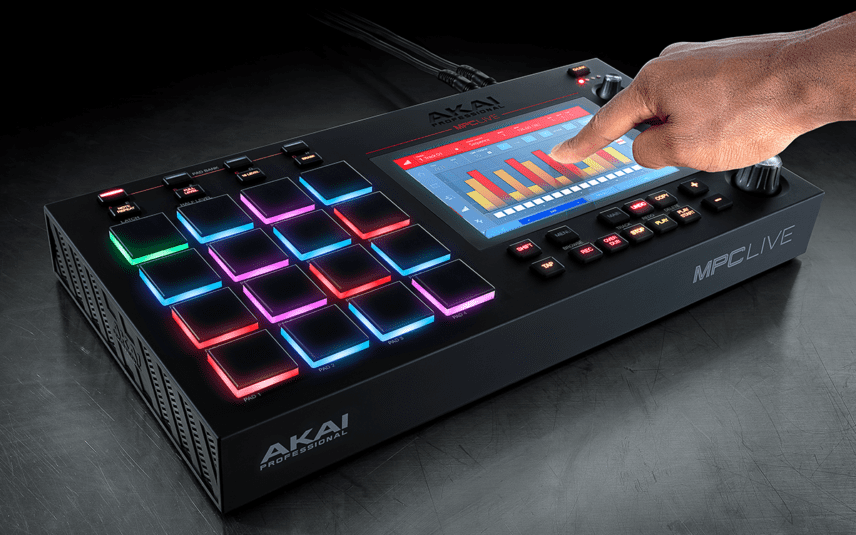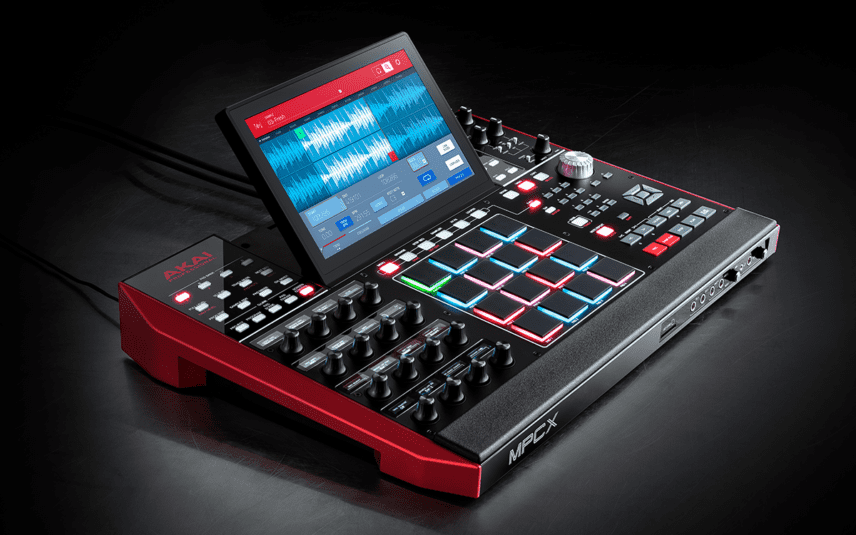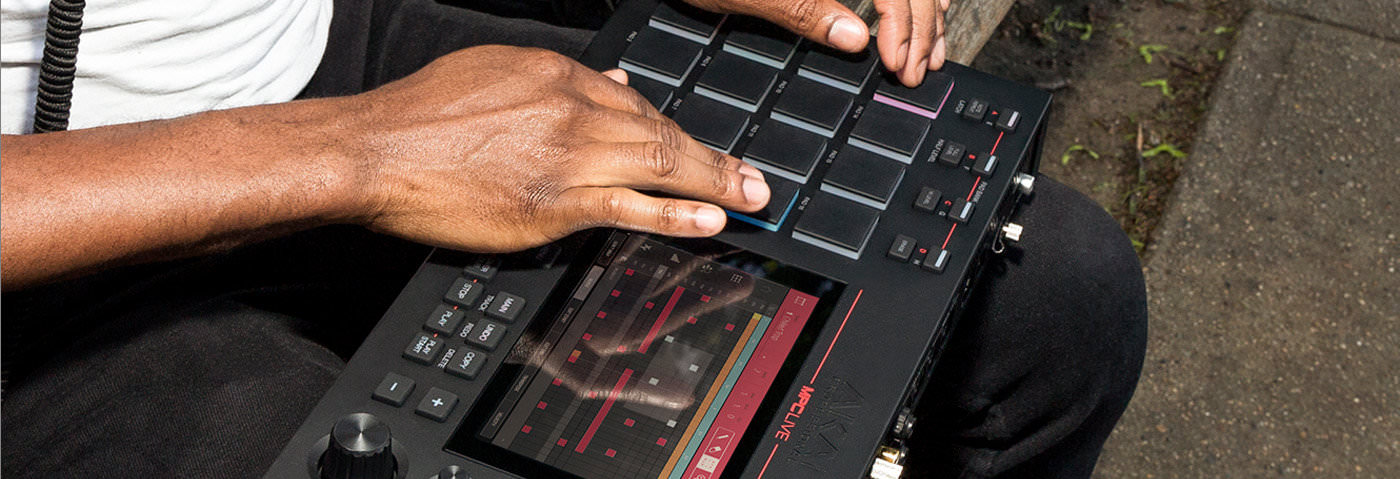Akai return to standalone mode with the current MPC range. We put the X and Live side by side to see how they stack up.
Success isn’t always easy to deal with. Blazing a trail with a revolutionary product can mean you end up living in its shadow, struggling to live up to its legacy. It’s a lot like a long-running movie franchise: the weight of expectation from fans can mean any change to the previous formula is met with suspicion. To misquote one example, with great success comes great responsibility.
You can understand why Akai’s MPC series fits into this category. The first of Akai’s sampler-sequencers was released in 1988, and the series has remained in production ever since, evolving to keep up with advances in technology and changes in studio techniques. The result is that disparate groups of MPC users cherish it for very different reasons. There are the diehard devotees of the earliest units – the MPC60 and MPC3000 – who overlook their relatively limited feature sets in favour of the way they colour the sound. There are those who appreciate all the bells and whistles of the later versions, which more closely represent the idea of an entire studio in a single box. There are even some who hack the older units with alternative operating systems, adding features and possibilities the designers never intended.
In retrospect, the MPC series probably lost its way a little when it tried to react to the DAW revolution of the early 2000s.
In retrospect, the MPC series probably lost its way a little when it tried to react to the DAW revolution of the early 2000s. The name of 2013’s MPC Renaissance seems particularly ironic in retrospect, with the hybrid software-hardware approach intended to represent a rebirth but also reflecting a huge change in the approach. MPCs had always been standalone units, instruments in their own right. If you needed a computer to use the new model, didn’t that take detract from what made so many people like the earlier units in the first place?
The Renaissance and the later MPC Touch weren’t bad products per se, but if the reaction on forums and comments sections was anything to go by, they left a lot of MPC fans nonplussed at best. It didn’t help that the arrival of NI’s hybrid Maschine in 2009 meant that the MPC series faced its strongest competition in years, free from the baggage of the MPC’s 20-year history.

The announcement of the two latest incarnation of the MPC series signalled a major shift back towards standalone operation. The MPC Live and MPC X once again untie themselves from computer integration, while retaining the benefits of the touchscreen introduced with the MPC Touch. In fact, both models can also be used as controllers if you want, linking in to your DAW and the MPC Software just like the hybrid models. Call it the best of both worlds.
Both models can also be used as controllers if you want. Call it the best of both worlds.
The cheaper MPC Live is very similar in appearance to the MPC Touch, released a couple of years ago. The unit is deeper and of course heavier but there’s clearly a lot of Touch DNA in the Live. That’s no bad thing. The hardware is well designed and the controls work well despite the relatively small number of physical knobs and buttons on the front panel (it goes without saying that the MPC’s iconic 4×4 grid of touch-sensitive pads is also present).
Both of these units run MPC Software 2, which is a big step up from the first generation, incorporating features that you’d probably associate with DAWs rather than MPCs. The Live and X can still be used for the basic sample-and-sequence approach that we’ve been familiar with from previous MPCs, but the inclusion of warping, clip launching and automatic beat matching certainly expand the potential of these latest models. It’s easy to speculate that Akai took a few hints from Ableton Live when developing the software, which is certainly no bad thing.
MPC workflow is an interesting conundrum in some ways: right from the very earliest 1980s models, the units have always been considered user friendly, but many of the deeper options have often been quite convoluted in practice. That’s an inherent limitation of the hardware setup and relatively small screens rather than a criticism of the way they’re designed – it’s fair to say that software DAWs have a natural advantage when it comes to user interfaces. Overall, the current generation MPC workflow is the best yet but it does require some work if you’re a newcomer to the MPC approach. The distinction between Tracks, Programs, Sequences, Songs and so on is a legacy of the classic MPC models and will be familiar to anyone who’s used older iterations, but there’s a nagging doubt that it might not be the clearest approach for newcomers. Nevertheless, the touch screen approach clearly helps to simplify processes and speed things up, as do the assignable Q-Link controls.
On paper, the X packs a similar feature set to the Live but in practice it’s clearly a step up
On paper, the X packs a similar feature set to the Live but in practice it’s clearly a step up: bigger screen, more inputs and outputs, four times as many Q-Link controls each with OLED labels, CV/gate outputs for sequencing analogue synths and modular hardware, plus about three times as many dedicated front panel controls for commonly used functions and quicker navigation. However, the X certainly isn’t cheap. Cynics might argue that you could get a decent laptop, software and controller for that kind of money, but that’s kind of missing the point. Laptops and DAWs still exist and you can still pick that approach if you want, but MPCs offer something different. The idea of a ‘studio in a box’ has become a cliche, but it was a radical idea when the original MPC60 was released and it pretty much defines what the MPC concept has always been about – hence the confusion when the range went hybrid with the Renaissance and Studio models. The X is the proper all-rounder of the range, more capable than any MPC that’s ever been before.

Despite the fact that the X is clearly the flagship model in the revamped MPC range, it’s not quite as simple as saying that it’s the best in every way. Realistically, its size (and the fact it requires a power supply) makes it much more of a studio option unless you want to lug it around as part of a fairly hefty live setup. While the Live might not have quite the same outright power, it’s got the advantage in terms of portability and frankly seems like it represents better value for money than the X.
To return to the action movie comparisons, the MPC X and MPC Live feel like a reboot of the MPC franchise, setting it back on track. This is no Dark Knight-style reimagining of a much-loved character, but a return to what made people love the series in the first place. The fanbase should be happy.
MPC X & MPC Live – Akai
